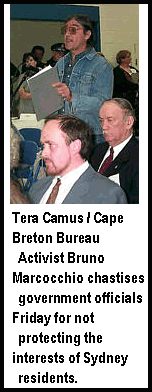
 Sydney - Three levels of government announced Friday a $62-million, three-year plan to combat
Sydney's mammoth toxic waste problem.
Sydney - Three levels of government announced Friday a $62-million, three-year plan to combat
Sydney's mammoth toxic waste problem.  Environmentalist Bruno Marcocchio got into a "Yes, you do," "No, I don't" exchange with Ms.
Stewart during a brief question period for the public.
Environmentalist Bruno Marcocchio got into a "Yes, you do," "No, I don't" exchange with Ms.
Stewart during a brief question period for the public. ![]()

